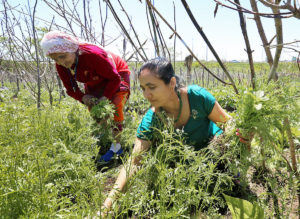
Khadga Acharya, right, and her mother-in-law, Kala Acharya, harvest an early season crop of herbs from their family’s garden plot in Madison. Wisconsin’s growing season has lengthened by about 12 days, allowing production of longer-season crop types and varieties. (Photo credit: John Hart – State Journal)
Yes. There are several studies that demonstrate shifts in the timing and length of the growing season.
One way to measure the length of the growing season is to count the number of days between the last frost in spring and the first frost in fall. By this measure, Wisconsin’s growing season lengthened by about 12 days between 1950 and 2006.
Longer growing seasons allow production of longer-season crop types and varieties.
The Growing Degree Days, or GDD, is a heat index that is related to plant development and is used to predict when a crop will reach maturity.
Each day’s GDD is calculated by subtracting a reference temperature, which varies with plant species, from the daily mean temperature, setting values less than zero to zero.
The reference temperature for a given plant is the temperature below which development for that plant either slows or stops.For example, cool season plants, like peas, have a reference temperature of 40 degrees, while warm season plants, like sweet corn and soybeans, have a reference temperature of 50 degrees.
The development of plants depends on the accumulation of heat. Since cool season plants have a lower reference temperature, they accumulate GDDs faster than warm season plants.
When drought or pests do not overly stress plants, the summation of the GDD can be used to measure the accumulation of heat and thus predict when a crop will reach maturity.
GDDs can be computed using climatic temperatures of an area. With that computation, we can estimate good crops to grow in a given region, similar to plant hardy zones. The longer growing season and warmer temperatures results in a changing GDD that is favorable to warm season plants.

